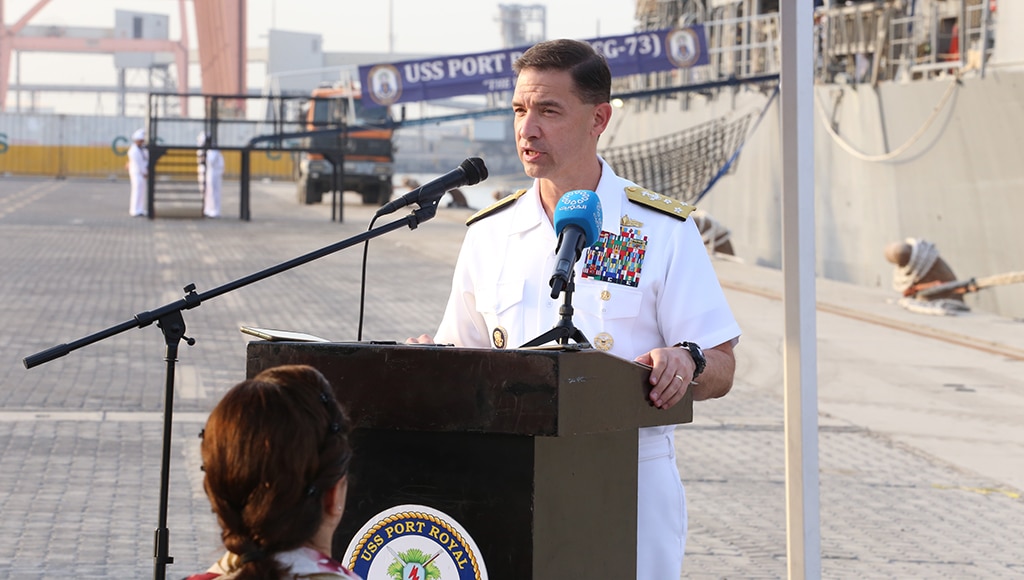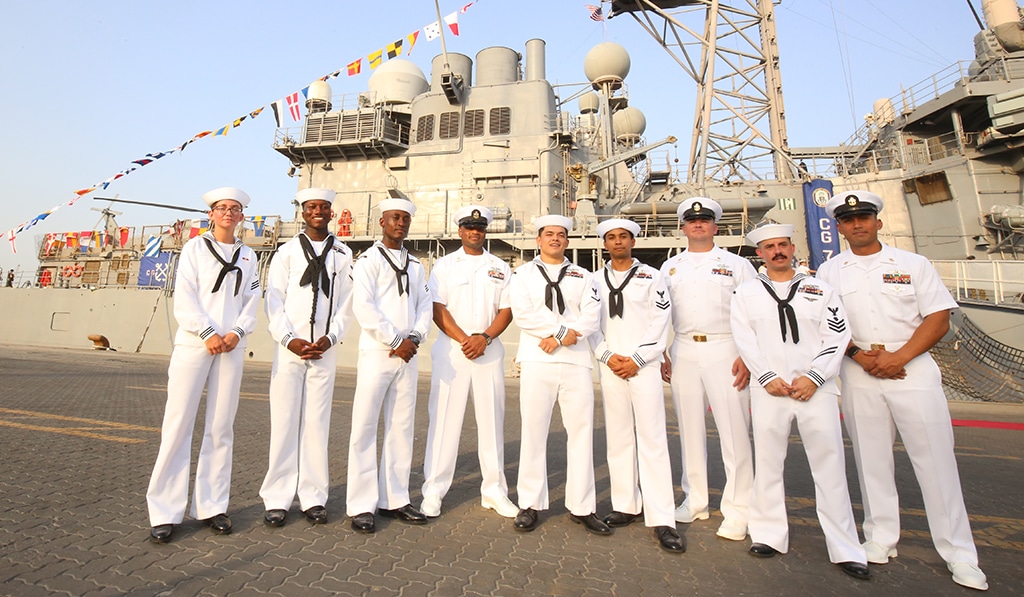By Faten Omar
KUWAIT: US warship USS Port Royal arrived in Kuwait to participate in maneuvers and exercises with the Kuwaiti Navy and Coast Guard on Tuesday. In a press conference, Vice Admiral Brad Cooper Commander, US Naval Forces Central Command, said the United States and Kuwait have maintained a highly productive military partnership over the past several decades, stating the Port Royal is just one display of bilateral commitment to strengthen the longstanding naval partnership.
"We will meet several leaders in the country, and I'm also here to express our deep continued commitment to our long strategic relationship. We will continue to pursue having Kuwaiti personnel and ships training and operating alongside us. Kuwait's Navy and Coast Guard continue to be valued partners, and we are committed to working together far into the future to ensure security and stability in the waters of the Arabian Gulf," he added.
Cooper pointed out that Kuwait-US coast guards and navies remain bound by shared interests in maintaining regional maritime security and stability, as well as countering terrorism. "We are discussing plans with Kuwait to conduct joint patrols in bilateral and multilateral formats. We are also developing plans to enhance cooperation and communication to deter aggression and smuggling.
He stressed that Kuwait is leading Combined Task Force 152, one of four task forces under Combined Maritime Forces -the largest international naval partnership in the world, praising Kuwait's efforts in leading with incredible energy and innovation, in addition to setting a new standard as it tackles illicit activity off the coastline.
 Admiral Brad Cooper Commander, US Naval Forces Central Command, speaks at the event.
Admiral Brad Cooper Commander, US Naval Forces Central Command, speaks at the event.
Cooper revealed that there is a potential to cooperate with Kuwait to integrate artificial intelligence (AI) in naval vessels during their daily operations in the Arabian Gulf, noting the importance of these new technologies that help in improving the image of the surrounding seas to achieve safer seas and stronger protection of global trade. "The coasts of the Arabian Gulf and the Red Sea are more than 8,000 kilometers, which makes maintaining its security extremely difficult, and there is no naval force that can roam and cover it all by itself," he said.
Cooper said by the summer of 2023, the US Navy, in cooperation with its allies in the region, will launch hundreds of these ships connected to satellites, and they can take and send pictures from the seas and gulfs of the region in support of the region's efforts to confront criminal and illegal acts. "I believe there is great potential for Kuwait to join US Navy efforts to integrate unmanned and artificial intelligence capabilities into our day-to-day operations at sea. We will demonstrate on Tuesday current capabilities at the Mohammed Al-Ahmad Kuwait Naval Base of two types of unmanned surface vessels we are operating across the region: A high-speed unmanned surface vessel, the fastest in the world, and a high-endurance unmanned surface vessel that we've seen remain at sea for more than 100 days without any stops for fuel or maintenance," he added.
USS Port Royal (CG-73) is a United States Navy Ticonderoga-class guided-missile cruiser. Commissioned in July 1994, she is the 27th and final in the class. Port Royal is the second US warship to bear the name of the two naval battles of Port Royal Sound, South Carolina - of the American Revolutionary War and the American Civil War. At the time of her naming, the Navy designated her as "first ship named" by way of a plaque in the Engineering Control Center, but this was in error as there was a previous ship to bear the name.
Modern US Navy guided-missile cruisers perform primarily in a Battle Force role. These ships are multi-mission Air Warfare (AW), Undersea Warfare (USW), Naval Surface Fire Support (NSFS), and Surface Warfare (SUW) surface combatants capable of supporting carrier battle groups, amphibious forces, or operating independently and as flagships of surface action groups. Cruisers are equipped with Tomahawk cruise missiles giving them additional long-range strike warfare capability. Some Aegis Cruisers have been outfitted with a Ballistic Missile Defense (BMD) capability.
Technological advances in the Standard Missile coupled with the Aegis combat system in the Ticonderoga class cruisers have increased the Anti-Air Warfare (AAW) capability of surface combatants to pinpoint accuracy from wave-top to zenith. Under the FY15 National Defense Authorization Act, Congress directed modernization in accordance with the "2-4-6" plan, which allowed the Navy to modernize two Cruisers a year, remain under modernization for no more than four years, and allow no more than six ships to undergo modernization at any one time.





